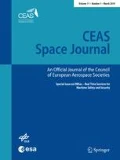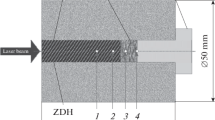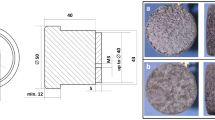Abstract
A method for assessing the performance of typical heat shield materials is presented in this paper. Three different material samples, the DLR material Zuram, the Airbus material Asterm and the carbon preform Calcarb were tested in the IRS plasma wind tunnel PWK1 at the same nominal condition. State of the art diagnostic tools, i.e., surface temperature with pyrometry and thermography and boundary layer optical emission spectroscopy were completed by photogrammetric surface recession measurements. These data allow the assessment of the net heat flux for each material. The analysis shows that the three materials each have a different effect on heat flux mitigation with ASTERM showing the largest reduction in surface heat flux. The effect of pyrolysis and blowing is clearly observed and the heat flux reduction can be determined from an energy balance.








Similar content being viewed by others
References
Anderson, J.D.: Hypersonic and High-Temperature Gas Dynamics, 2nd edn. AIAA Education Series (2006)
Löhle, S., Hermann, T., Zander, F., Fulge, H., Marynowski, T.: Ablation radiation coupling investigation in earth re-entry using plasma wind tunnel experiments. In: 30th Aerodynamic Measurement Technology and Ground Testing Conference. AIAA (2014)
Johnson, S.: Thermal protection materials and systems: past and future. In: 40th International Conference and Exposition on Advanced Ceramics and Composites (2015)
Cassell, A., Winter, M., Allen, G.A., Grinstead, J.H., Antimisiaris, M. E., Albers, J., Jenniskens, P.: Hayabusa re-entry: trajectory analysis and observation misson design. In: 42nd AIAA Thermophysics Conference. AIAA (2011)
Röck, W., Auweter-Kurtz, M.: Spectral measurements in the boundary layer of probes in nitrogen/methane plasma flows. In: 32nd Thermophysics Conference. AIAA-1997-2525, Atlanta (1997) (June 23–25)
Marynowski, T., Löhle, S., Fasoulas, S.: Two-photon absorption laser-induced fluorescence investigation of CO2 Plasmas for Mars Entry, AIAA J. Thermophys. Heat Transfer 28(3) (2014)
Herdrich, G., Dropmann, M., Marynowski, T., Löhle, S., Fasoulas, S.: Atmospheric entry simulation capabilities of the IRS plasma wind tunnel PWK3 for Mars and Venus. In: 7th International Planetary Probe Workshop 2010, planetaryprobe.eu. Barcelona (2010)
Zander, F., Marynowski, T., Löhle, S.: High-speed imaging of a steady state CO2 plasma flow. J. Thermophys. Heat Transfer 31, 451–462 (2017)
Loehle, S., Fasoulas, S., Herdrich, G., Hermann, T., Massuti-Ballester, B., Pagan, A.S., Zander, F.: The Plasma Wind Tunnels at the Institute of Space Systems: current status and challenges. In: 46th Aerodynamic Measurement Technology and Ground Testing Conference. AIAA (2016)
Löhle, S., Brandis, A., Hermann, T., Peter, J.: Numerical Investigation of the Re-entry Flight of Hayabusa and Comparison to Flight and Ground Testing Data. In: 43rd AIAA Thermophysics Conference. AIAA, New Orleans (2012)
Hermann, T., Zander, F., Fulge, H., Löhle, S., Fasoulas, S.: Characterization of a Re-entry Plasma Wind Tunnel Flow with Vacuum Ultraviolet to Near Infrared Spectroscopy. J. Thermophys. Heat Transfer 30, 673–688 (2016)
Kolesnikov, A.F.: Extrapolation from high enthalpy tests to flight based on the concept of local heat transfer simulation. In: Measurement Techniques for High Enthalpy and Plasma Flows, No. 8B. VKI, RTO—Research and Technology Organization, Rhode–Saint–Genese (1999)
Sakraker, I., Turchi, A., Chazot, O.: Hypersonic aerothermochemistry duplication in ground plasma facilities: a flight-to-ground approach. J. Spacecr Rockets (2015)
Turchi, A., Matesanz Saiz, J.J., Magin, T.E., Chazot, O.: On the flight extrapolation of stagnation-point ablative material plasma wind tunnel tests. In: 8th European Symposium on Aerothermodynamics for Space Vehicles (2015)
Löhle, S., Fuchs, U., Digel, P., Hermann, T., Battaglia, J.-L.: Analysing inverse heat conduction problems by the analysis of the system impulse response. In: Inverse Problems in Science and Engineering (2013)
Hermann, T., Löhle, S., Leyland, P., Marraffa, L., Bouilly, J.-M., Fasoulas, S.: First results on ablation radiation coupling through optical emission spectroscopy from the vacuum ultraviolet to the visible. In: 8th European Symposium on Aerothermodynamics for Space Vehicles. Lisbon (2015)
Zander, F., Marynowski, T., Loehle, S.: High Speed Spectral Analysis of a Steady State CO\(_2\) Plasma. In: 6th International Workshop on Radiation of High Temperature Gases in Atmospheric Entry. ESA, St. Andrews (2014)
Loehle, S., Staebler, T., Reimer, T., Cefalu, A.: Photogrammetric surface analysis of ablation processes in high enthalpy air plasma flow. AIAA J. 53(11), 3187–3195 (2015)
Loehle, S., Steinbeck, A., Fasoulas, S.: Local Mass-Specific Enthalpy Measurements with a New Mass Injection Probe. J. Thermophys Heat Transfer 30, 301–307 (2015)
Loehle, S., Jenniskens, P., Lips, T., Bastida-Virgili, B., Albers, J., Zander, F., Krag, H., Grinstead, J. H., Bacon, J.: Preparations of the Airborne ATV-5 Re-entry Observation Campaign. In: 12th International Planetary Probe Workshop (2015)
Loehle, S., Jenniskens, P.: High resolution spectroscopy of the hayabusa re-entry using a Fabry-Perot Interferometer. J. Spacecr. Rockets 51(6), 1986–1993 (2014)
Eberhart, M., Löhle, S., Steinbeck, A., Binder, T., Fasoulas, S.: Measurement of atomic oxygen in the middle atmosphere using solid electrolyte sensors and catalytic probes. Atmos. Meas. Tech. 8(9), 3701–3714 (2015)
Bouilly, J.-M., Leleu, F.: Ablative thermal protections for planetary entry: an overview. In: 4th International Symposium on Atmospheric Reentry Vehicles and Systems. Arcachon (2005) (21–25 March 2005)
Reimer, T., Loehle, S., Öfele, R.: Photogrammetric surface recession measurements on ablative ssamples of various shape. Materials Science and Technology, Columbus (2015)
Wright, M.J., Beck, R.A.S., Edquist, K.T., Driver, D., Sepka, S.A., Slimko, E.M., Willcockson, W.H., DeCaro, A., Hwang, H.H.: Sizing and margins assessment of the mars science laboratory aeroshell thermal protection system. J. Spacecr. Rockets 51(4), 1125–1138 (2009)
Hermann, T., Loehle, S., Fasoulas, S., Leyland, P., Marraffa, L., Bouilly, J.-M.: Influence of ablation on vacuum-ultraviolet radiation in a plasma wind tunnel flow. J. Thermophys. Heat Transfer 31, 575–585 (2016)
MacDonald, M.E., Jacobs, C., Laux, C.O., Zander, F., Morgan, R.: Measurements of air plasma/ablator interactions in an inductively coupled plasma torch. J. Thermophys. Heat Transfer 29(1), 12–23 (2015)
Bouilly, J.-M., Plaindoux, C.: ASTERM: Maturation of a new low density ablative material. In: 7th European Workshop on Thermal Protection Systems and Hot Structures. ESA (2013)
Zuber, C., Rothermel, T., Herdrich, G., Walpot, L.: A lightweight ablative material for research purposes. In: 7th Ablation Workshop (2015)
Helber, B., Chazot, O., Magin, T., Hubin, A.: Ablation of carbon preform in the VKI Plasmatron. 43d Thermophysics Conference, No. AIAA, pp. 2012–2876. AIAA (2012)
Covington, M.A., Heinemann, J.M., Goldstein, H.E., Chen, Y.-K., Terrazas-Salinas, I., Balboni, J.A., Olejniczak, J., Martinez, E.R.: Performance of a low density ablative heat shield material. J. Spacecr. Rockets 45(2), 237–247 (2008)
Tran, H.K., Johnson, C.E., Rasky, D.J., et al.: Phenolic impregnated carbon ablators (PICA) as thermal protection systems for diseovery missions, Tech. Rep. TM 110440. NASA (1997)
Zoby, E.V.: Empirical stagnation-point heat-transfer relation in several gas mixtures at high enthalpy levels. NASA Technical Note, No. TN D-4799 (1968)
de Crombrugghe, G., Morgan, R., Chazot, O.: Theoretical approach and experimental verification of the role of diffusive transport under binary scaling conditions. Int. J. Heat Mass Transfer 97, 675–682 (2016)
Hermann, T., Zander, F., Loehle, S., Fasoulas, S.: Experimental Assessment of Aerothermodynamics in a High Enthalpy Plasma Wind Tunnel Flow. J. Quant. Spectrosc. Radiat. Transfer 201, 216–225 (2017)
Milos, F.S., Chen, Y.-K.: Ablation and thermal response porperty model validation for phenolic impregnated ablator. AIAA J. Spacecr. Rockets 47(5) (2010)
Chen, Y.-K., Gökçen, T.: Effect of nonequilibrium surface thermochemistry in simulation of carbon-based ablators. AIAA J. Spacecr. Rockets 50(3) (2013)
Investigation of CN Production from Carbon Materials in Nitrogen Plasmas (2010)
Zander, F., Loehle, S., Hermann, T., Fulge, H.: Fabry-Perot spectroscopy for kinetic temperature and velocity measurements of a high enthalpy air plasma flow. J. Appl. Phys. D (2016) (in preparation)
Mora-Monteros, J., Fahy, E., Banerji, N., Leyland, P.: Ablation Radiation Coupling for the Hayabusa Trajectory. In: 6th International Workshop on Radiation of High Temperature Gases in Atmospheric Entry. ESA (2014)
Acknowledgements
The authors would like to thank the partners, Dr. Penelope Leyland (EPFL) and Jean-Marc Bouilly (Airbus DS) in the ESA project Ablation Radiation Coupling (Contract Nr. 4000106422/12/NL/AF) for supporting this work and the feedback to the data analysis. We also thank Lionel Marraffa for continuous support and many fruitful discussions throughout the project. We thank T. Reimer from the German Aerospace Center for supporting this analysis by providing Zuram material samples and J.M. Bouilly for providing Asterm samples.
Author information
Authors and Affiliations
Corresponding author
Rights and permissions
About this article
Cite this article
Löhle, S., Hermann, T. & Zander, F. Experimental assessment of the performance of ablative heat shield materials from plasma wind tunnel testing. CEAS Space J 10, 203–211 (2018). https://doi.org/10.1007/s12567-017-0186-0
Received:
Revised:
Accepted:
Published:
Issue Date:
DOI: https://doi.org/10.1007/s12567-017-0186-0




